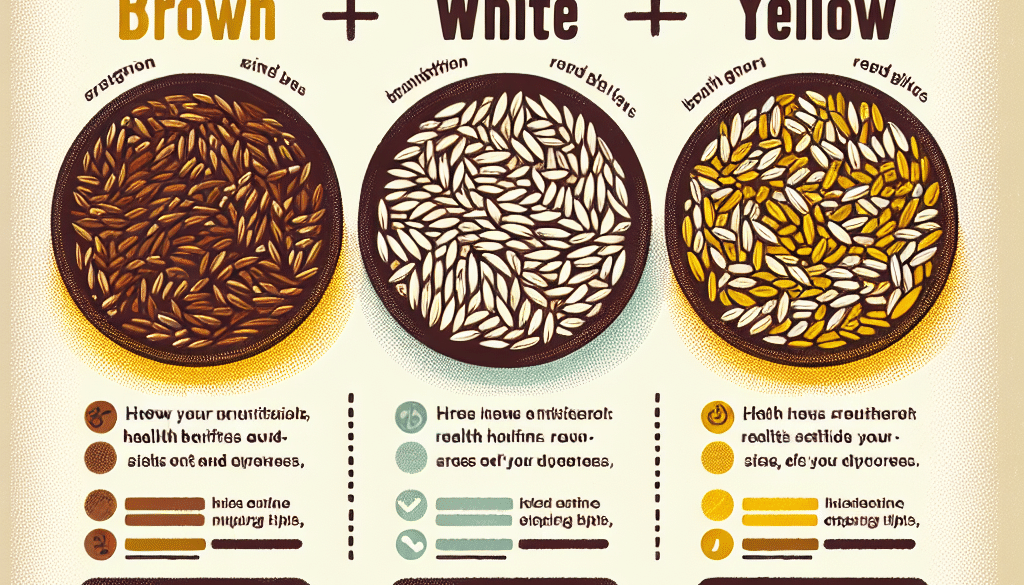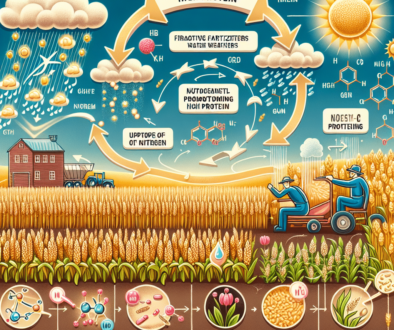Which Rice Is Healthier Brown White Or Yellow?
-
Table of Contents
- Comparing Rice Varieties: Brown, White, and Yellow for Optimal Health
- Nutritional Overview of Brown, White, and Yellow Rice
- Health Benefits and Drawbacks of Each Rice Type
- Brown Rice: The Whole Grain Champion
- White Rice: The Refined Staple
- Yellow Rice: The Flavorful Alternative
- Comparative Studies and Statistics
- Which Rice Should You Choose?
- Conclusion: Balancing Health with Personal Preferences
- Enhance Your Diet with ETprotein’s Protein Products
Comparing Rice Varieties: Brown, White, and Yellow for Optimal Health

Rice is a staple food for over half of the world’s population, and it comes in various forms, each with its unique nutritional profile. Among the most common types of rice consumed are brown, white, and yellow rice. Consumers often face the dilemma of choosing the healthiest option. This article delves into the nutritional differences between these rice varieties to help you make an informed decision about which rice is healthier for your diet.
Nutritional Overview of Brown, White, and Yellow Rice
Understanding the nutritional content of brown, white, and yellow rice is crucial in determining which is the healthiest choice. Here’s a breakdown of their key nutritional differences:
- Brown Rice: This whole grain rice has the outer hull removed but retains the bran and germ layers, which are rich in nutrients. It is high in fiber, vitamins, minerals, and antioxidants.
- White Rice: White rice is milled to remove the bran and germ, leaving only the starchy endosperm. This process strips away many nutrients, although some white rice is enriched with vitamins and minerals.
- Yellow Rice: Yellow rice is typically white rice that has been colored with turmeric or saffron. While it contains the added health benefits of these spices, its nutritional profile is similar to that of white rice.
Health Benefits and Drawbacks of Each Rice Type
Brown Rice: The Whole Grain Champion
Brown rice is often touted as the healthiest option among the three. Its high fiber content aids in digestion and can help prevent constipation. The presence of bran and germ means it is rich in essential nutrients like magnesium, phosphorus, selenium, thiamine, niacin, and vitamin B6. Additionally, brown rice has a low glycemic index, which means it causes a slower rise in blood sugar levels, making it a better choice for individuals with diabetes.
White Rice: The Refined Staple
White rice is more processed than brown rice, which results in a loss of nutrients. However, it is often enriched with iron and B vitamins to compensate for this loss. White rice has a higher glycemic index, which can lead to quicker spikes in blood sugar levels. It is also easier to digest due to its lower fiber content, which may be beneficial for individuals with digestive issues.
Yellow Rice: The Flavorful Alternative
Yellow rice gets its color from turmeric or saffron, which are spices known for their anti-inflammatory properties and potential health benefits. Turmeric contains curcumin, a compound with antioxidant and anti-inflammatory effects. However, the amount of turmeric used in yellow rice is usually small, so the health benefits may not be as significant as consuming the spice directly.
Comparative Studies and Statistics
Several studies have compared the health effects of consuming different types of rice. For instance, research has shown that regular consumption of brown rice is associated with a lower risk of type 2 diabetes, while white rice consumption has been linked to an increased risk. Additionally, brown rice has been found to contribute to better cardiovascular health due to its higher fiber content.
Statistics from dietary surveys indicate that populations that consume more whole grains, such as brown rice, tend to have lower rates of obesity and related chronic diseases. This suggests that the nutritional benefits of whole grains play a significant role in maintaining overall health.
Which Rice Should You Choose?
When deciding which rice to incorporate into your diet, consider the following factors:
- Dietary Needs: If you require more fiber and nutrients, brown rice is the superior choice. For those with digestive sensitivities, white rice may be more appropriate.
- Health Goals: If you’re managing blood sugar levels or aiming to reduce the risk of chronic diseases, brown rice is the better option.
- Taste and Texture Preferences: Some people prefer the softer texture and neutral taste of white rice, while others enjoy the nutty flavor and chewy texture of brown rice.
- Culinary Uses: Yellow rice can add color and flavor to dishes, making it a popular choice for certain recipes.
Conclusion: Balancing Health with Personal Preferences
In conclusion, brown rice stands out as the healthiest choice due to its whole grain content, fiber, and rich nutrient profile. White rice is less nutritious but may be suitable for those with specific dietary needs. Yellow rice offers additional flavor and potential health benefits from spices but is nutritionally similar to white rice. Ultimately, the healthiest rice for you depends on your individual health goals, dietary requirements, and taste preferences.
Enhance Your Diet with ETprotein’s Protein Products
If you’re looking to complement your healthy rice choice with high-quality protein, consider ETprotein’s range of organic protein products. Their organic rice protein is an excellent addition to a balanced diet, especially for those seeking plant-based protein sources. ETprotein’s products are non-GMO, allergen-free, and come with a neutral taste, making them a versatile ingredient for various dietary needs.
About ETprotein:
ETprotein, a reputable protein and L-(+)-Ergothioneine (EGT) Chinese factory manufacturer and supplier, is renowned for producing, stocking, exporting, and delivering the highest quality organic bulk vegan proteins and L-(+)-Ergothioneine. They include Organic rice protein, clear rice protein, pea protein, clear pea protein, watermelon seed protein, pumpkin seed protein, sunflower seed protein, mung bean protein, peanut protein, and L-(+)-Ergothioneine EGT Pharmaceutical grade, L-(+)-Ergothioneine EGT food grade, L-(+)-Ergothioneine EGT cosmetic grade, L-(+)-Ergothioneine EGT reference grade and L-(+)-Ergothioneine EGT standard. Their offerings, characterized by a neutral taste, non-GMO, allergen-free attributes, with L-(+)-Ergothioneine purity over 98%, 99%, cater to a diverse range of industries. They serve nutraceutical, pharmaceutical, cosmeceutical, veterinary, as well as food and beverage finished product distributors, traders, and manufacturers across Europe, USA, Canada, Australia, Thailand, Japan, Korea, Brazil, and Chile, among others.
ETprotein specialization includes exporting and delivering tailor-made protein powder and finished nutritional supplements. Their extensive product range covers sectors like Food and Beverage, Sports Nutrition, Weight Management, Dietary Supplements, Health and Wellness Products, and Infant Formula, ensuring comprehensive solutions to meet all your protein needs.
As a trusted company by leading global food and beverage brands and Fortune 500 companies, ETprotein reinforces China’s reputation in the global arena. For more information or to sample their products, please contact them and email sales(at)ETprotein.com today.












